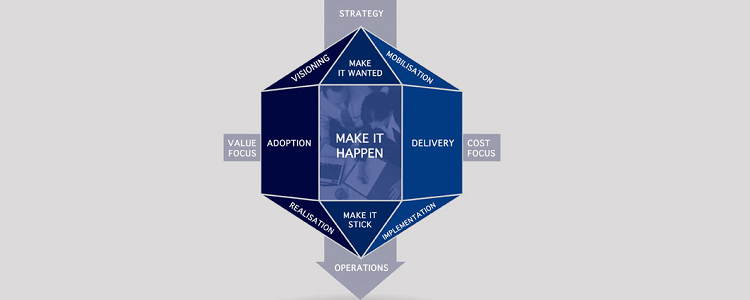
Directed or managed change is the way organisations translate their deliberate strategies into reality. For most organisations the vehicle used to initiate and structure change is its portfolio of projects. It is, therefore, the linking of business outcomes to project outputs that is at the heart of change management.
CITI developed the change diamond to structure the different facets of projects and change, linking value to costs, strategy with operations , and delivery to adoption, so that the investment of effort, time and money is channeled into the realisation of benefits not producing outputs – and thus focused on delivering effective and valued change.
The ‘change’ lifecycle is separated into three stages:
- The first stage is to make the change wanted – this is the fundamental step of engaging stakeholders, establishing the value and aligning the outcomes with the values and needs of the business. From this come the benefits and business cases, the enterprise portfolio and the translation of the deliberate strategy to the emergent or delivered strategy.
- The second stage is to make the change happen. Though much of the cost arises in the delivery side of the diamond, much of the really important work in structuring the organisation to achieve the benefits is done during this step. For many IT-intensive organisations, the management focus and urgency of making the delivery overwhelms the attention needed by the change process leading to its neglect – which is the cause of real difficulties later in converting the project deliverables into valued outcomes. The change diamond draws attention to change governance concerns that are often overlooked. Experience shows that by giving the change agenda primacy during this stage; reversing the common approach of defining the project and its strategy from an analysis of deliverables, tasks and resources and instead using the temporal and logical needs of the change to shape the way the project is planned and executed yields far better results.
- The third stage, and the one least well addressed by many change processes, is making the change stick. Though this is where the value of the investment is returned, it commonly receives the least senior management attention. Making it stick means passing the baton on from informed teams heavily involved in delivering the change – whether as members of the project or as part of the change agency – to business-as-usual individuals with considerably less participation to date. ‘Tacking on’ benefits realisation to the end of project delivery is an unsafe and uncertain process. The change diamond illustrates the linkages that can and should be established, and the impact on the flow of governance of the delivery and adoption processes of focusing on realising the value of project investment.









